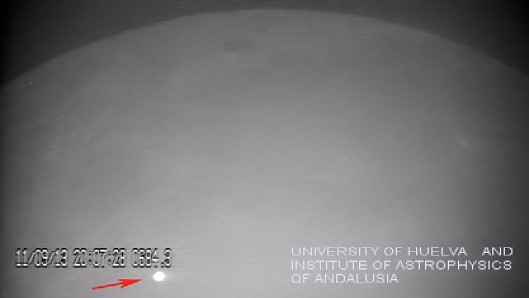As a handy reminder that flying space debris is everywhere and rams into things all the time, an approximately 882 pound meteorite rammed into the moon recently, and astronomers caught it on video. It was the brightest known lunar impact with a glow that rivaled the North Star, and now everyone can see it.
The asteroid impact was recorded by the MIDAS (Moon Impacts Detection and Analysis System) lunar impact monitoring study, being carried out by Professor Jose Madiedo’s team at the University of Huelva in Spain.
Hundreds of lunar impacts have been recorded using video cameras gazing through amateur-class telescopes since the process began in the late 1990s, adding substance to centuries of visual observations of so-called transient lunar phenomena. Most impacts, however, were at the threshold of detection with these instruments.
For convenience, the number of video frames on which an impact event could be seen established a rough field criterion for describing its intensity. Most events are visible for a few frames, and about once a year an impact can be seen for 10-20 frames. In contrast, the September 11 impact was visible for a full eight seconds at normal video rates, indicating that it was by far the most energetic impact seen in this study.
Working out the numbers reveals that the asteroid had a mass of about 400 kg (880 lb), and was roughly a meter (3.3 ft) in size. Traveling at 17 km/s (10.5 miles-per-second), it struck the Moon’s surface at 20:07 GMT. The impact is estimated to have released about 60 billion joules (17,000 kWh), the equivalent of about 15 tons of TNT.
Agencies/Canadajournal
 Canada Journal – News of the World Articles and videos to bring you the biggest Canadian news stories from across the country every day
Canada Journal – News of the World Articles and videos to bring you the biggest Canadian news stories from across the country every day



